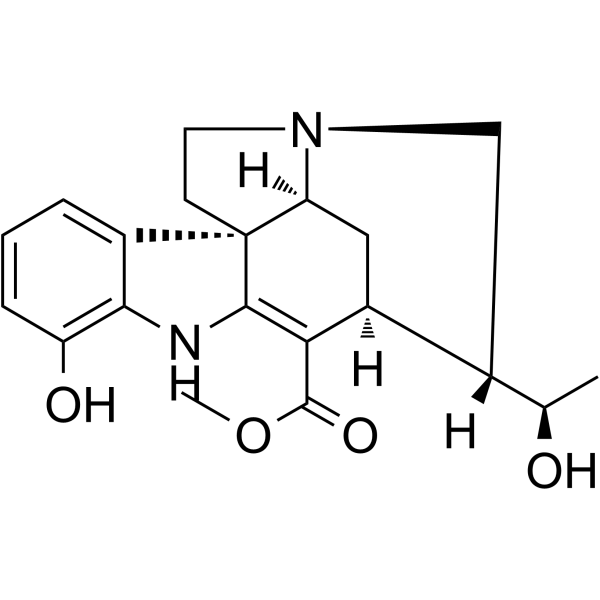19-epi-ScholaricineCAS# 132923-06-9 |

Quality Control & MSDS
Package In Stock
Number of papers citing our products

| Cas No. | 132923-06-9 | SDF | Download SDF |
| PubChem ID | N/A | Appearance | Powder |
| Formula | C20H24N2O4 | M.Wt | 356.42 |
| Type of Compound | Indoles | Storage | Desiccate at -20°C |
| Synonyms | Alstoniascholarine O,19-Epischolaricine | ||
| Solubility | Soluble in Chloroform,Dichloromethane,Ethyl Acetate,DMSO,Acetone,etc. | ||
| General tips | For obtaining a higher solubility , please warm the tube at 37 ℃ and shake it in the ultrasonic bath for a while.Stock solution can be stored below -20℃ for several months. We recommend that you prepare and use the solution on the same day. However, if the test schedule requires, the stock solutions can be prepared in advance, and the stock solution must be sealed and stored below -20℃. In general, the stock solution can be kept for several months. Before use, we recommend that you leave the vial at room temperature for at least an hour before opening it. |
||
| About Packaging | 1. The packaging of the product may be reversed during transportation, cause the high purity compounds to adhere to the neck or cap of the vial.Take the vail out of its packaging and shake gently until the compounds fall to the bottom of the vial. 2. For liquid products, please centrifuge at 500xg to gather the liquid to the bottom of the vial. 3. Try to avoid loss or contamination during the experiment. |
||
| Shipping Condition | Packaging according to customer requirements(5mg, 10mg, 20mg and more). Ship via FedEx, DHL, UPS, EMS or other couriers with RT, or blue ice upon request. | ||

19-epi-Scholaricine Dilution Calculator

19-epi-Scholaricine Molarity Calculator
| 1 mg | 5 mg | 10 mg | 20 mg | 25 mg | |
| 1 mM | 2.8057 mL | 14.0284 mL | 28.0568 mL | 56.1136 mL | 70.142 mL |
| 5 mM | 0.5611 mL | 2.8057 mL | 5.6114 mL | 11.2227 mL | 14.0284 mL |
| 10 mM | 0.2806 mL | 1.4028 mL | 2.8057 mL | 5.6114 mL | 7.0142 mL |
| 50 mM | 0.0561 mL | 0.2806 mL | 0.5611 mL | 1.1223 mL | 1.4028 mL |
| 100 mM | 0.0281 mL | 0.1403 mL | 0.2806 mL | 0.5611 mL | 0.7014 mL |
| * Note: If you are in the process of experiment, it's necessary to make the dilution ratios of the samples. The dilution data above is only for reference. Normally, it's can get a better solubility within lower of Concentrations. | |||||

Calcutta University

University of Minnesota

University of Maryland School of Medicine

University of Illinois at Chicago

The Ohio State University

University of Zurich

Harvard University

Colorado State University

Auburn University

Yale University

Worcester Polytechnic Institute

Washington State University

Stanford University

University of Leipzig

Universidade da Beira Interior

The Institute of Cancer Research

Heidelberg University

University of Amsterdam

University of Auckland

TsingHua University

The University of Michigan

Miami University

DRURY University

Jilin University

Fudan University

Wuhan University

Sun Yat-sen University

Universite de Paris

Deemed University

Auckland University

The University of Tokyo

Korea University
- Odoratisol B
Catalog No.:BCX1669
CAS No.:891182-94-8
- Uvariol
Catalog No.:BCX1668
CAS No.:56362-97-1
- Copteroside G
Catalog No.:BCX1667
CAS No.:86438-31-5
- Inonotusol F
Catalog No.:BCX1666
CAS No.:1534433-74-3
- (-)-10-epi-α-Cyperone
Catalog No.:BCX1665
CAS No.:2303-31-3
- (1E)-3-Methoxy-8,12-epoxygermacra-1,7,10,11-tetraen-6-one
Catalog No.:BCX1664
CAS No.:383368-26-1
- Rubrofusarin-6-O-β-D-glucopyranoside
Catalog No.:BCX1663
CAS No.:132922-80-6
- Glucodichotomine B
Catalog No.:BCX1662
CAS No.:845673-16-7
- Podecdysone C
Catalog No.:BCX1661
CAS No.:19458-46-9
- lagunamine
Catalog No.:BCX1660
CAS No.:126721-42-4
- (E)-Isoconiferin (Citrusin D)
Catalog No.:BCX1659
CAS No.:113349-27-2
- 1,2,3,7-Tetrahydroxy-8-methoxy-6-methyl-9,10-anthracenedione
Catalog No.:BCX1658
CAS No.:130018-57-4
- Anhuienoside B
Catalog No.:BCX1671
CAS No.:1233510-75-2
- Garcinielliptone HD
Catalog No.:BCX1672
CAS No.:1008376-90-6
- Lupulone C
Catalog No.:BCX1673
CAS No.:613683-50-4
- Cararosinol A
Catalog No.:BCX1674
CAS No.:651733-57-2
- Peimisine 3-O-β-D-glucopyranoside
Catalog No.:BCX1675
CAS No.:1407161-78-7
- Macrostemonoside I
Catalog No.:BCX1676
CAS No.:162413-63-0
- Malabaricone B
Catalog No.:BCX1677
CAS No.:63335-24-0
- 6'-Hydroxyjusticidin C
Catalog No.:BCX1678
CAS No.:904328-26-3
- α-Thevetin B
Catalog No.:BCX1679
CAS No.:144300-21-0
- Cannogenol 3-O-β-gentiobiosyl-(1→4)-α-L-thevetoside
Catalog No.:BCX1680
CAS No.:1841524-78-4
- 2'- O -Acetylthevetin A
Catalog No.:BCX1681
CAS No.:1356494-03-5
- (7’S)-N-trans-Feruloylnormetanephrine
Catalog No.:BCX1682
CAS No.:2705170-78-9
Targeted quantitative analysis of monoterpenoid indole alkaloids in Alstonia scholaris by ultra-high-performance liquid chromatography coupled with quadrupole time of flight mass spectrometry.[Pubmed:37349854]
J Sep Sci. 2023 Sep;46(17):e2200843.
Monoterpene indole alkaloids exhibit structural diversity in herbal resources and have been developed as promising drugs owing to their significant biological activities. Confidential identification and quantification of monoterpene indole alkaloids is the key to quality control of target plants in industrial production but has rarely been reported. In this study, quantitative performance of three data acquisition modes of ultra-high-performance liquid chromatography coupled with quadrupole time-of-flight mass spectrometry including full scan, auto-MS(2) and target-MS(2) , was evaluated and compared for specificity, sensitivity, linearity, precision, accuracy, and matrix effect using five monoterpene indole alkaloids (scholaricine, 19-epi-Scholaricine, vallesamine, picrinine, and picralinal). Method validations indicated that target-MS(2) mode showed predominant performance for simultaneous annotation and quantification of analytes, and was then applied to determine monoterpene indole alkaloids in Alstonia scholaris (leaves, barks) after extraction procedures optimization using Box-Behnken design of response surface methodology. The variations of A. scholaris monoterpene indole alkaloids in different plant parts, harvest periods, and post-handling processes, were subsequently investigated. The results indicated that target-MS(2) mode could improve the quantitative capability of ultra-high-performance liquid chromatography coupled with quadrupole time-of-flight mass spectrometry for structure-complex monoterpene indole alkaloids in herbal matrices. Alstonia scholaris, monoterpene indole alkaloids, quadrupole time of flight mass spectrometry, qualitative and quantitative analysis, ultra-high-performance liquid chromatography.


